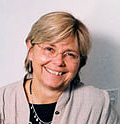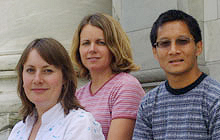|
Contact Us Harvard Medical School
Telephone 617-432-0442 |
|
Click |
NEWS ALERT
Harvard Medical School Office of Public Affairs
Lab Pioneers New Approach to RNAi Screen Data-sharing
BOSTON, Mass. (Aug. 10, 2008) — The recent explosion of genetic screens fostered by a process called RNA interference (RNAi) imbues scientists with new responsibilities when it comes to sharing information. After researchers use RNAi to knock down hundreds of genes (by interfering with the protein templates they produce) and troll for players in key biological processes, they’re blessed—and burdened—with massive piles of data, more than a single lab could ever process.

Dr. Joan Brugge
Research teams generally follow up on a few hits and then either ignore the other data or relegate it to the supplemental tables of papers, which are difficult to mine. But Joan Brugge’s lab at Harvard Medical School took a different approach.
“After screening for genes that influence cell migration, we validated all of the hits through extensive secondary screens and quantification of the knockdown, and then we developed a user-friendly, interactive database, granting unprecedented access to the resulting information,” explains Brugge, who is chair of the HMS Department of Cell Biology. The database—available at http://www.cellmigration.org/—complements a Nature Cell Biology paper published online Aug. 10.
Brugge is also a member of the Cell Migration Consortium, which fosters collaboration among seemingly disparate labs from more than 20 institutions. The new database embodies the group’s ethos, bringing participants closer to understanding a biological process that’s key to both normal development and cancer progression.
“We need to move beyond supplemental tables to fully capitalize on RNAi screens and advance our understanding of complex processes such as cell migration,” says Brugge. “The new online database fosters data-sharing, dialogue, and follow-up studies.”
Postdoctoral researcher Kaylene Simpson laid the foundation for the database at the ICCB-Longwood Screening Facility by knocking down 1,081 genes—one at a time—in human breast cells. She then analyzed the ability of each population of cells to repair a wound, which shed light on the missing gene’s role in cell migration. She identified genes that seemed to increase or decrease cell migration and conducted additional experiments to validate those hits.
“I knew that other labs would use my data as a resource, so the validation was critical, and we conducted numerous experiments to be sure of our hits,” says Simpson.
She populated the database with information from each experiment. She even included time-lapse movies of wounds healing, when appropriate. “Researchers can see exactly how these cells move when we inhibit particular genes,” explains Simpson. “Based on all of our data, we’re highly confident that at least 66 of the 1,081 genes influence cell migration. Many of these promising candidates surprised us, and they deserve more attention.”
“This exceptionally systematic and stringent screen has advanced the study of cell migration by identifying a large number of genes involved in the process,” adds James Deatherage, who oversees cell motility grants at the National Institute of General Medical Sciences. “The publicly available, interactive database resulting from this work is a model for data sharing and will be a substantial asset for future efforts in the migration and metastasis fields.”
This research is supported by the National Institute of General Medical Sciences and the Department of Defense. Thermo Fisher Scientific supported this work by supplying reagents, siRNA expertise and analysis of siRNA knockdown.
Written by Alyssa Kneller
CITATION:
Nature Cell Biology. Online Aug. 10, 2008
“Identification of genes that regulate epithelial cell migration using an siRNA screening approach.”
Kaylene J. Simpson (1), Laura M. Selfors (1), James Bui (1), Angela Reynolds (2), Devin Leake (2), Anastasia Khvorova (2), and Joan S. Brugge (1)
CONTACT:
Alyssa Kneller
public_affairs@hms.harvard.edu
617.432.0442
Harvard Medical School has more than 7,500 full-time faculty working in 11 academic departments located at the School's Boston campus or in one of 47 hospital-based clinical departments at 18 Harvard-affiliated teaching hospitals and research institutes. Those affiliates include Beth Israel Deaconess Medical Center, Brigham and Women's Hospital, Cambridge Health Alliance, Children's Hospital Boston, Dana-Farber Cancer Institute, Forsyth Institute, Harvard Pilgrim Health Care, Hebrew SeniorLife, Joslin Diabetes Center, Judge Baker Children's Center, Immune Disease Institute, Massachusetts Eye and Ear Infirmary, Massachusetts General Hospital, McLean Hospital, Mount Auburn Hospital, Schepens Eye Research Institute, Spaulding Rehabilitation Hospital, and VA Boston Healthcare System.


